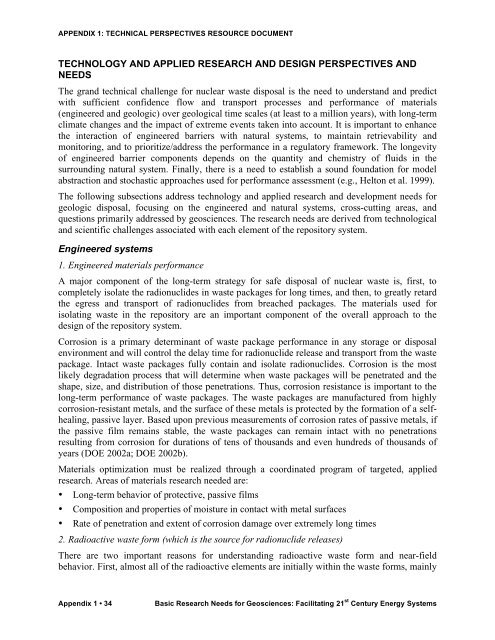Basic Research Needs for Geosciences - Energetics Meetings and ...
Basic Research Needs for Geosciences - Energetics Meetings and ...
Basic Research Needs for Geosciences - Energetics Meetings and ...
- No tags were found...
Create successful ePaper yourself
Turn your PDF publications into a flip-book with our unique Google optimized e-Paper software.
APPENDIX 1: TECHNICAL PERSPECTIVES RESOURCE DOCUMENTTECHNOLOGY AND APPLIED RESEARCH AND DESIGN PERSPECTIVES ANDNEEDSThe gr<strong>and</strong> technical challenge <strong>for</strong> nuclear waste disposal is the need to underst<strong>and</strong> <strong>and</strong> predictwith sufficient confidence flow <strong>and</strong> transport processes <strong>and</strong> per<strong>for</strong>mance of materials(engineered <strong>and</strong> geologic) over geological time scales (at least to a million years), with long-termclimate changes <strong>and</strong> the impact of extreme events taken into account. It is important to enhancethe interaction of engineered barriers with natural systems, to maintain retrievability <strong>and</strong>monitoring, <strong>and</strong> to prioritize/address the per<strong>for</strong>mance in a regulatory framework. The longevityof engineered barrier components depends on the quantity <strong>and</strong> chemistry of fluids in thesurrounding natural system. Finally, there is a need to establish a sound foundation <strong>for</strong> modelabstraction <strong>and</strong> stochastic approaches used <strong>for</strong> per<strong>for</strong>mance assessment (e.g., Helton et al. 1999).The following subsections address technology <strong>and</strong> applied research <strong>and</strong> development needs <strong>for</strong>geologic disposal, focusing on the engineered <strong>and</strong> natural systems, cross-cutting areas, <strong>and</strong>questions primarily addressed by geosciences. The research needs are derived from technological<strong>and</strong> scientific challenges associated with each element of the repository system.Engineered systems1. Engineered materials per<strong>for</strong>manceA major component of the long-term strategy <strong>for</strong> safe disposal of nuclear waste is, first, tocompletely isolate the radionuclides in waste packages <strong>for</strong> long times, <strong>and</strong> then, to greatly retardthe egress <strong>and</strong> transport of radionuclides from breached packages. The materials used <strong>for</strong>isolating waste in the repository are an important component of the overall approach to thedesign of the repository system.Corrosion is a primary determinant of waste package per<strong>for</strong>mance in any storage or disposalenvironment <strong>and</strong> will control the delay time <strong>for</strong> radionuclide release <strong>and</strong> transport from the wastepackage. Intact waste packages fully contain <strong>and</strong> isolate radionuclides. Corrosion is the mostlikely degradation process that will determine when waste packages will be penetrated <strong>and</strong> theshape, size, <strong>and</strong> distribution of those penetrations. Thus, corrosion resistance is important to thelong-term per<strong>for</strong>mance of waste packages. The waste packages are manufactured from highlycorrosion-resistant metals, <strong>and</strong> the surface of these metals is protected by the <strong>for</strong>mation of a selfhealing,passive layer. Based upon previous measurements of corrosion rates of passive metals, ifthe passive film remains stable, the waste packages can remain intact with no penetrationsresulting from corrosion <strong>for</strong> durations of tens of thous<strong>and</strong>s <strong>and</strong> even hundreds of thous<strong>and</strong>s ofyears (DOE 2002a; DOE 2002b).Materials optimization must be realized through a coordinated program of targeted, appliedresearch. Areas of materials research needed are:• Long-term behavior of protective, passive films• Composition <strong>and</strong> properties of moisture in contact with metal surfaces• Rate of penetration <strong>and</strong> extent of corrosion damage over extremely long times2. Radioactive waste <strong>for</strong>m (which is the source <strong>for</strong> radionuclide releases)There are two important reasons <strong>for</strong> underst<strong>and</strong>ing radioactive waste <strong>for</strong>m <strong>and</strong> near-fieldbehavior. First, almost all of the radioactive elements are initially within the waste <strong>for</strong>ms, mainlyAppendix 1 • 34<strong>Basic</strong> <strong>Research</strong> <strong>Needs</strong> <strong>for</strong> <strong>Geosciences</strong>: Facilitating 21 st Century Energy Systems
















